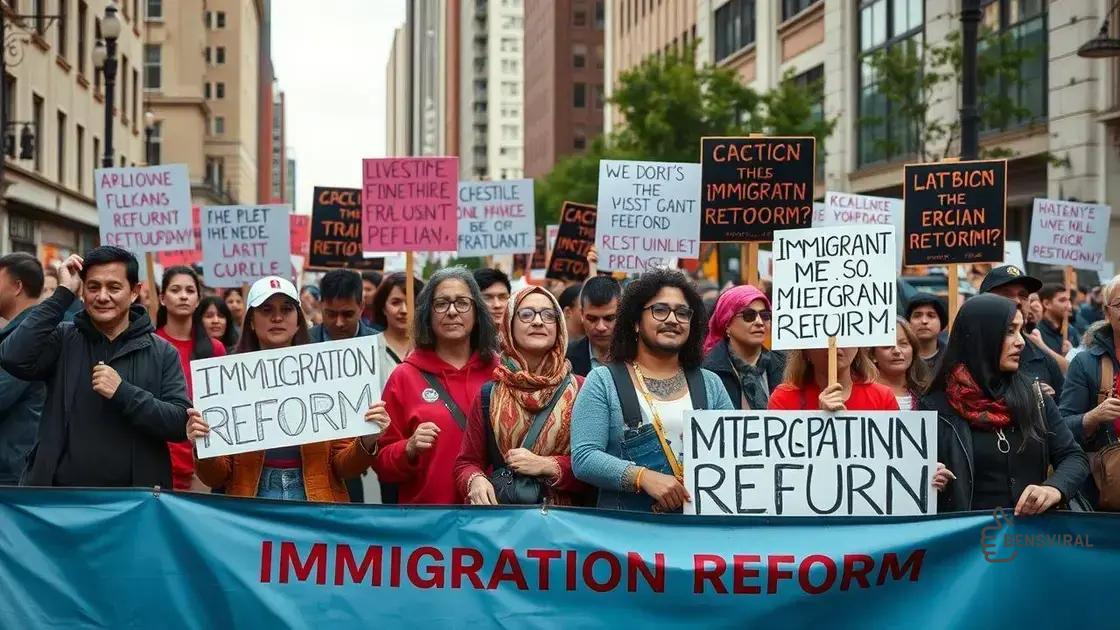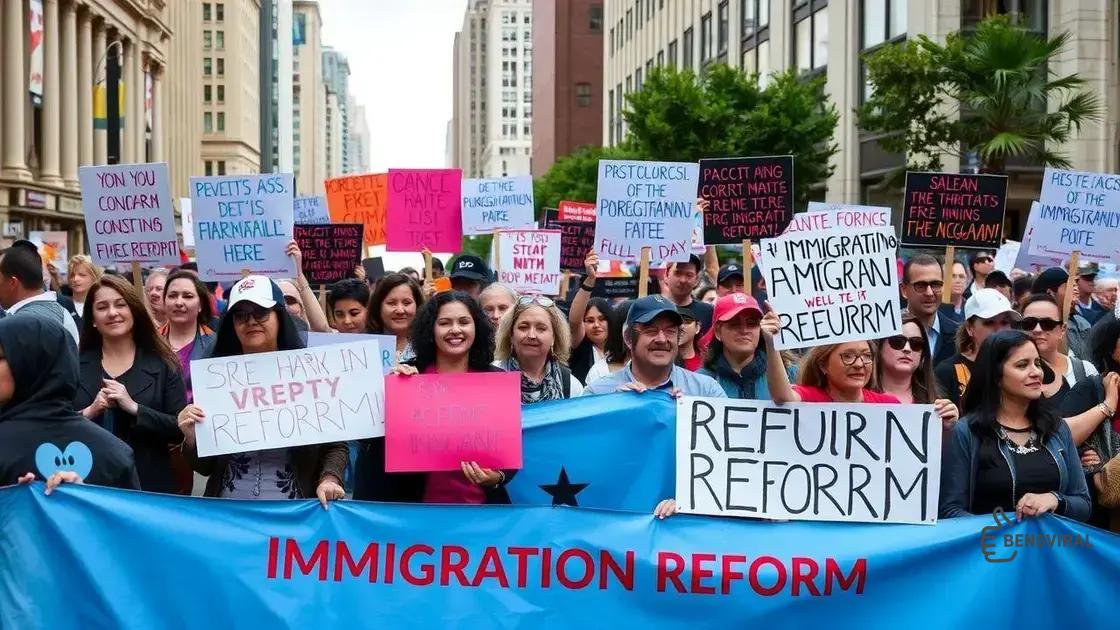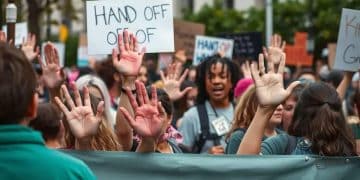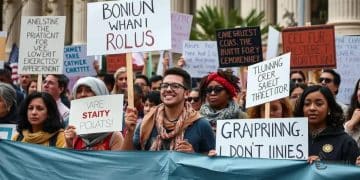Demonstrations targeting immigration reform policies and their impact

Demonstrations targeting immigration reform policies can significantly influence lawmakers and public opinion, advocating for essential changes in immigration laws through collective action and raising awareness of the challenges faced by immigrant communities.
Demonstrations targeting immigration reform policies are becoming a significant force in our society. Have you noticed how communities are rallying for change? These protests not only highlight prevailing issues but also encourage meaningful dialogue about our immigration system.
Understanding the history of immigration reform
Understanding the history of immigration reform is crucial for grasping the policies we see today. Over the decades, various laws have shaped our immigration landscape, reflecting societal values and economic needs.
For starters, let’s consider some pivotal moments in history. Each reform was often a response to economic pressures, social justice movements, or international crises. These moments help us see why immigration debates are so relevant now.
Key Legislative Acts
Several key legislative acts have been instrumental in reforming immigration laws. Each has influenced the way immigrants are treated and how policies are structured:
- The Immigration Act of 1924: This act aimed to limit the number of immigrants, particularly from Southern and Eastern Europe.
- The Hart-Celler Act of 1965: This major reform eliminated national origin quotas and created a more diverse immigration system.
- The Immigration Reform and Control Act of 1986: It granted amnesty to millions of undocumented immigrants.
Each wave of reform reveals the government’s shifting priorities. In the late 20th century, the focus shifted towards border control and security, influenced by various events and increasing public concern.
Public Sentiment and Reforms
Public opinion often sways immigration policies. In times of economic boom, there tends to be a more welcoming attitude toward immigrants. However, during downturns, sentiments can shift dramatically.
This fluctuation highlights the importance of public demonstrations. Activists have historically influenced lawmakers by rallying for change. Their voices help illuminate the needs and struggles of immigrant communities.
As discussions around immigration policy continue to evolve, understanding this history is vital. It gives context to current reforms and helps form arguments for future changes.
Key policies shaping immigration today
Key policies shaping immigration today are crucial to understanding how immigration functions in our society. These policies not only affect immigrants but also influence public perception and the economy.
Several significant areas define current immigration policy. The focus is often on securing borders while also addressing the needs of refugees and workers. Each of these policies is rooted in historical context and current events, which helps shape the dialogue around immigration.
Border Security Policies
Border security remains a top priority for many lawmakers. This involves various measures aimed at controlling the flow of people entering the country. Strategies include:
- Increased funding for border patrol: This ensures that more agents are available to monitor border activity.
- Use of technology: Surveillance systems and drones are deployed to enhance monitoring capabilities.
- Physical barriers: Fencing and walls have become controversial aspects of immigration strategy.
These measures often lead to debates about their effectiveness and humanitarian implications. It’s essential to consider how these policies impact both security and human rights.
Employment-Based Immigration Policies
Another vital area involves policies related to employment-based immigration. These policies focus on attracting skilled workers who can contribute to the economy. Some key components include:
- H-1B Visa Program: This allows U.S. companies to employ foreign workers in specialized fields.
- Green Card lottery: This lottery system provides a pathway for some immigrants to become permanent residents.
- Work permits for refugees: These permits enable refugees to begin working quickly upon arrival.
The balance between securing jobs for citizens and allowing skilled workers to enter the country is a delicate one. As the economy evolves, so do the needs and attitudes towards immigration.
These key policies reflect our nation’s changing views on immigration. Understanding how they shape the landscape can help individuals engage more meaningfully in the conversation around immigration reform.
The role of public demonstrations in policy change

The role of public demonstrations in policy change is significant in shaping immigration laws. These gatherings serve as a voice for those who often feel unheard, highlighting critical issues affecting communities. When people come together, it can attract media attention and influence public opinion.
One notable aspect of public demonstrations is their ability to unite diverse groups. Activists, immigrants, and allies rally around common goals, creating a powerful momentum for change. Such movements often lead to increased dialogue about immigration reform.
Impact of Social Movements
Social movements have historically played a pivotal role in policy changes across various issues. These movements aim to bring attention to injustices and advocate for reforms. A few ways social movements impact immigration policy include:
- Raising Awareness: Demonstrations educate the public about immigration challenges and encourage dialogue.
- Influencing Policymakers: Lawmakers may respond to the pressure created by large demonstrations and public sentiment.
- Creating Coalitions: Different groups often join forces to amplify their impact, leading to stronger advocacy.
Through these actions, demonstrators often seek to change hearts and minds. Public demonstrations create a platform where personal stories can be shared, connecting individuals to larger issues.
Case Studies of Successful Movements
Many successful public demonstrations throughout history have led to notable changes in immigration policy. For instance, the Dreamers movement has played a crucial role in shaping discussions around Deferred Action for Childhood Arrivals (DACA). These young immigrants have mobilized for their rights, creating compelling narratives that resonate with the public and lawmakers.
Similarly, various organizations have organized marches that highlight the plight of refugees. These events often receive extensive media coverage, leading to broader conversations about humanitarian responses to immigration crises.
Overall, public demonstrations provide an essential platform for advocating policy change. By bringing attention to immigration issues, they contribute to a more robust and dynamic discussion, which can ultimately lead to impactful reforms.
Case studies of successful reform movements
Case studies of successful reform movements demonstrate the power of collective action in achieving immigration changes. Each movement provides valuable lessons on advocacy and strategy.
One prominent example is the Dreamers movement, which focuses on individuals who came to the U.S. as children. They have fought for Deferred Action for Childhood Arrivals (DACA), a program that protects them from deportation. Their personal stories have connected with many people, driving significant media attention and public support.
The Farmworker Movement
Another notable case is the Farmworker Movement led by Cesar Chavez in the 1960s. This movement aimed to improve working conditions for migrant laborers. Through boycotts, strikes, and marches, farmworkers successfully gained better wages and labor rights. Key strategies included:
- Community Organizing: Chavez mobilized thousands by forming strong community ties.
- Public Awareness Campaigns: The movement raised awareness about the plight of farmworkers, drawing support from consumers.
- Direct Action: Boycotts of non-union grapes highlighted their concerns and left a lasting impact on consumers.
This movement not only secured better conditions for farmworkers but also paved the way for future immigrant rights movements.
The LGBTQ+ Immigration Movement
The LGBTQ+ Immigration Movement is also a vital part of immigration reform history. Advocates have pushed for policies that recognize the unique challenges faced by LGBTQ+ immigrants, especially in seeking asylum from persecution. Significant achievements include:
- Legal Protections: Many successful cases have set precedents for recognizing the need for protection from persecution.
- Support Networks: Organizations provide legal aid and community support for LGBTQ+ immigrants.
- Raising Awareness: Advocacy campaigns have highlighted the intersection of immigration and LGBTQ+ rights, increasing understanding in society.
The intersection of various movements shows how different causes can unite for a common goal. These case studies illustrate that public mobilization can lead to substantial policy changes, highlighting the importance of solidarity and shared strategies in advocating for a fair immigration system.
Future implications of ongoing demonstrations
Future implications of ongoing demonstrations hold great significance in shaping immigration policies. As communities continue to rally for change, the impact of these movements will likely grow stronger.
One important aspect to consider is how ongoing demonstrations can influence legislation. Lawmakers often pay attention to public sentiment, especially when large groups advocate for specific reforms. This means that continued pressure from the community can motivate representatives to propose or support new laws that reflect the demands of their constituents.
Shaping Public Opinion
Demonstrations also play a vital role in shaping public opinion. When people see others standing up for a cause, it can spark conversations. As stories of personal experiences are shared, more individuals become aware of the complexities surrounding immigration issues. This increased awareness can lead to:
- Greater Empathy: Understanding the struggles faced by immigrants can foster compassion in society.
- Community Engagement: Ongoing demonstrations encourage people to participate actively in discussions about immigration.
- Media Coverage: The media often highlights large demonstrations, further broadening the reach of the cause.
The ripple effect of these changes is essential. As public opinion shifts, political leaders can feel more empowered to advocate for reforms aligned with these values.
Potential Policy Outcomes
Ongoing demonstrations may also result in significant policy outcomes in the future. Activists and community members can unite around key issues such as family reunification, worker rights, and pathways to citizenship. These issues resonate deeply with many, making them focal points for future legislation.
As some policies become more favorable, we may see a push for comprehensive immigration reform that addresses the needs of various demographics. This can include pathways for undocumented individuals to gain legal status, protections for refugees, and more equitable treatment for immigrant workers.
In summary, the future of immigration reform is very much tied to the power of ongoing demonstrations. As communities continue to raise their voices, they help shape a more just and equitable immigration system that reflects society’s values.
In conclusion, public demonstrations play a crucial role in shaping immigration policies. Through collective action, communities raise awareness and advocate for change. These movements not only influence lawmakers but also engage the public in meaningful conversations about immigration issues. As communities continue to unite for justice, the future of immigration reform looks promising. Active participation in demonstrations can lead to essential policy changes that reflect society’s values and priorities.
FAQ – Frequently Asked Questions about Immigration Reform Demonstrations
How do public demonstrations affect immigration policy?
Public demonstrations draw attention to immigration issues, influencing lawmakers to consider reforms based on public sentiment.
What role do community organizations play in demonstrations?
Community organizations help mobilize support, organize events, and amplify the voices of those affected by immigration policies.
Can demonstrations lead to actual policy changes?
Yes, when demonstrations gain enough visibility and support, they can result in significant political pressure, leading to policy changes.
How do social media campaigns support demonstrations?
Social media campaigns help spread awareness, gather support, and connect like-minded individuals, making demonstrations more impactful.






